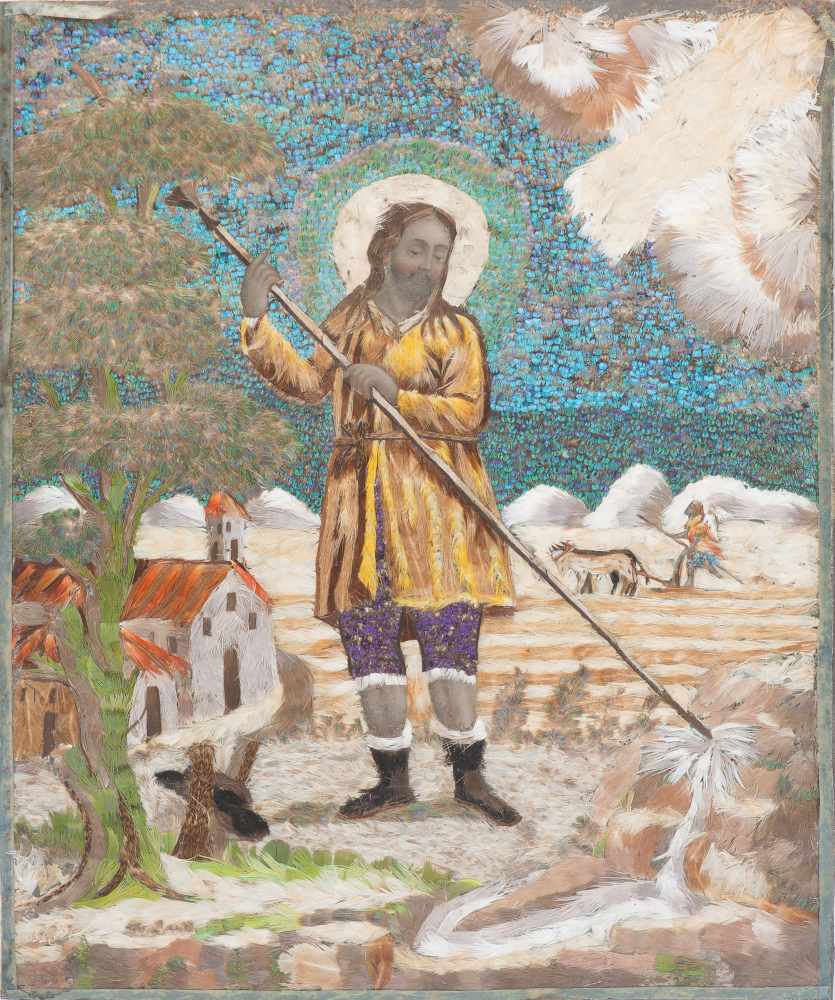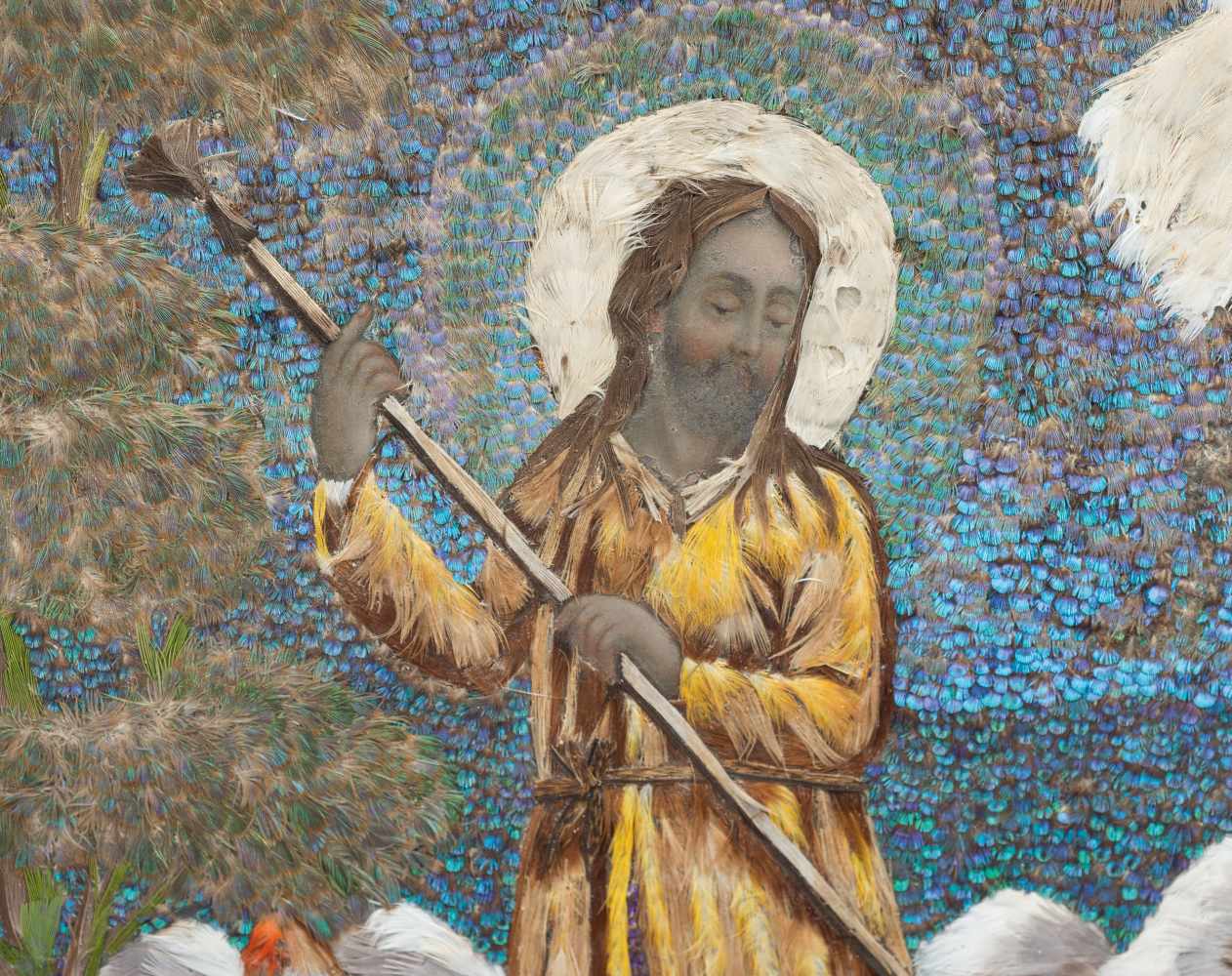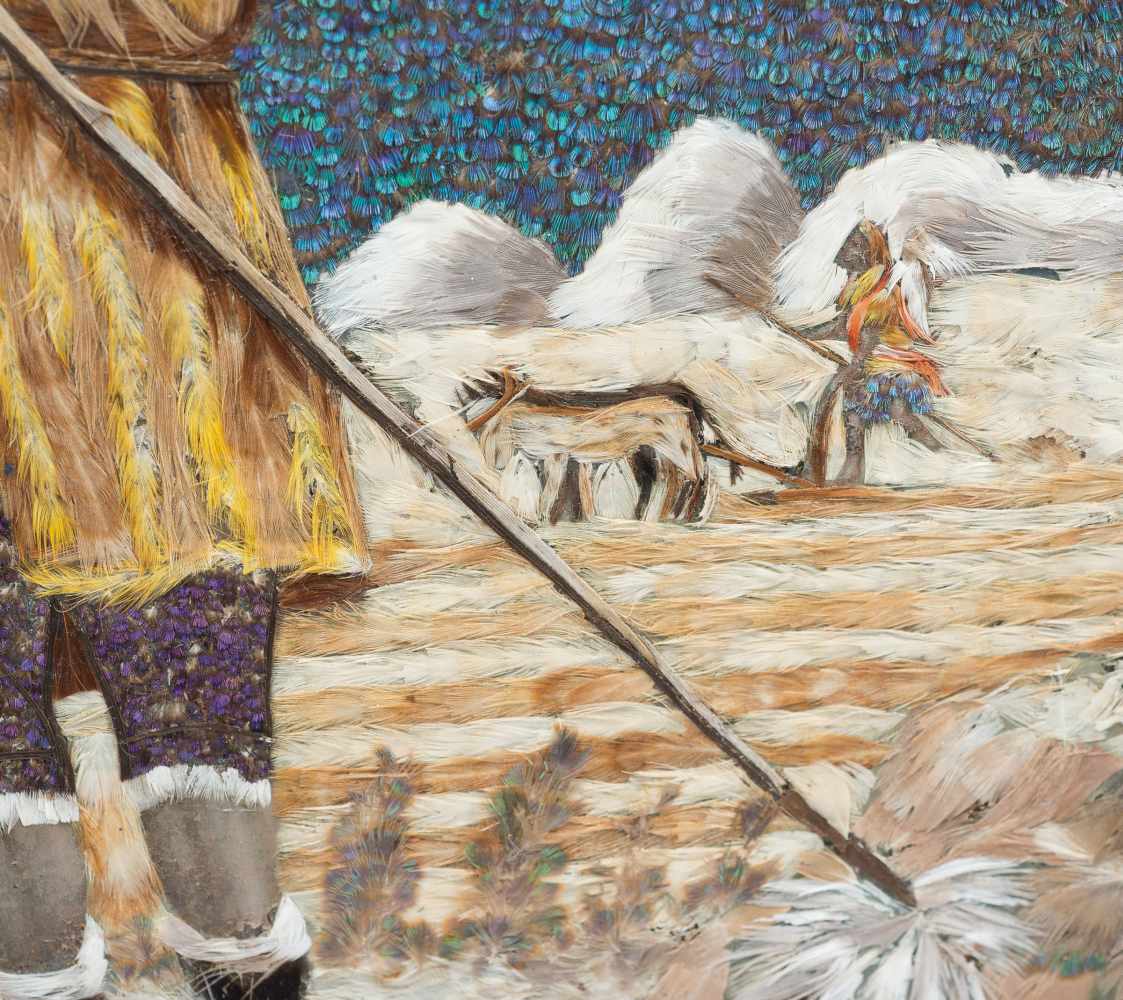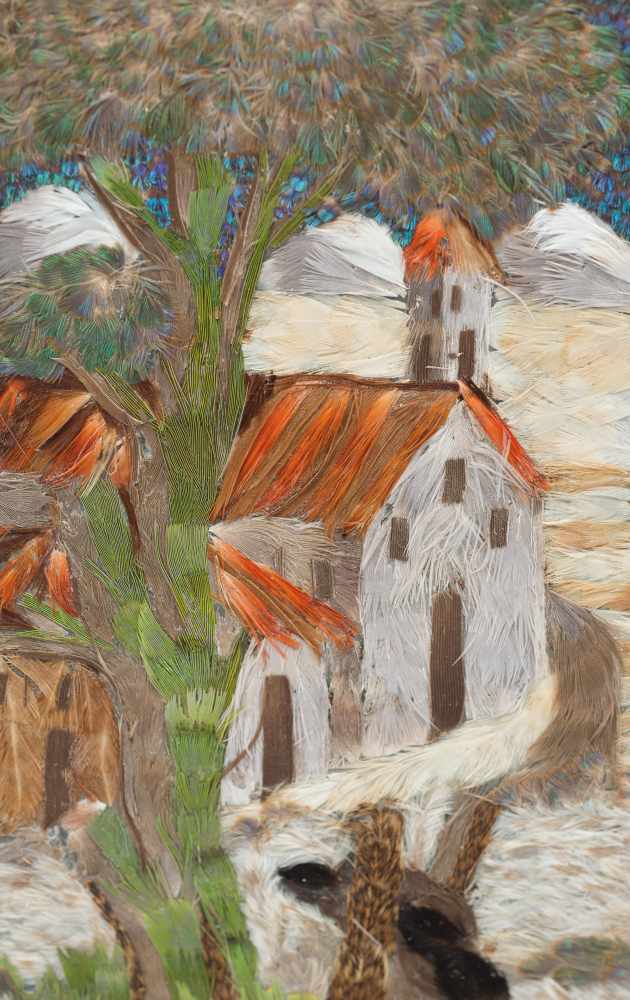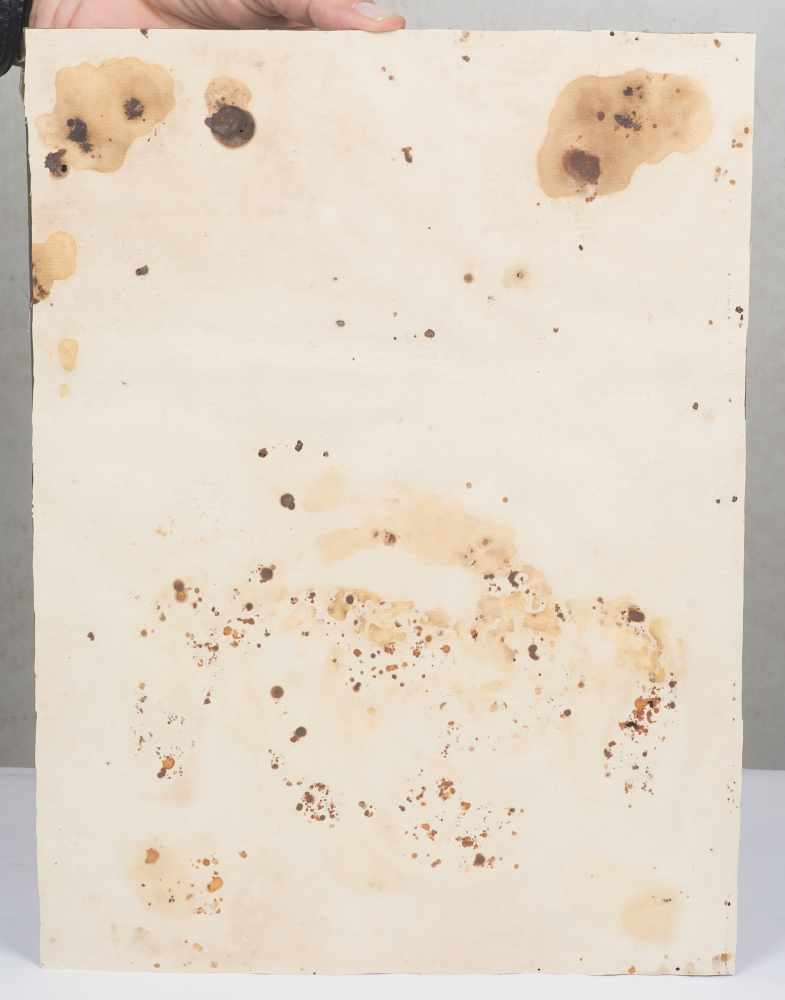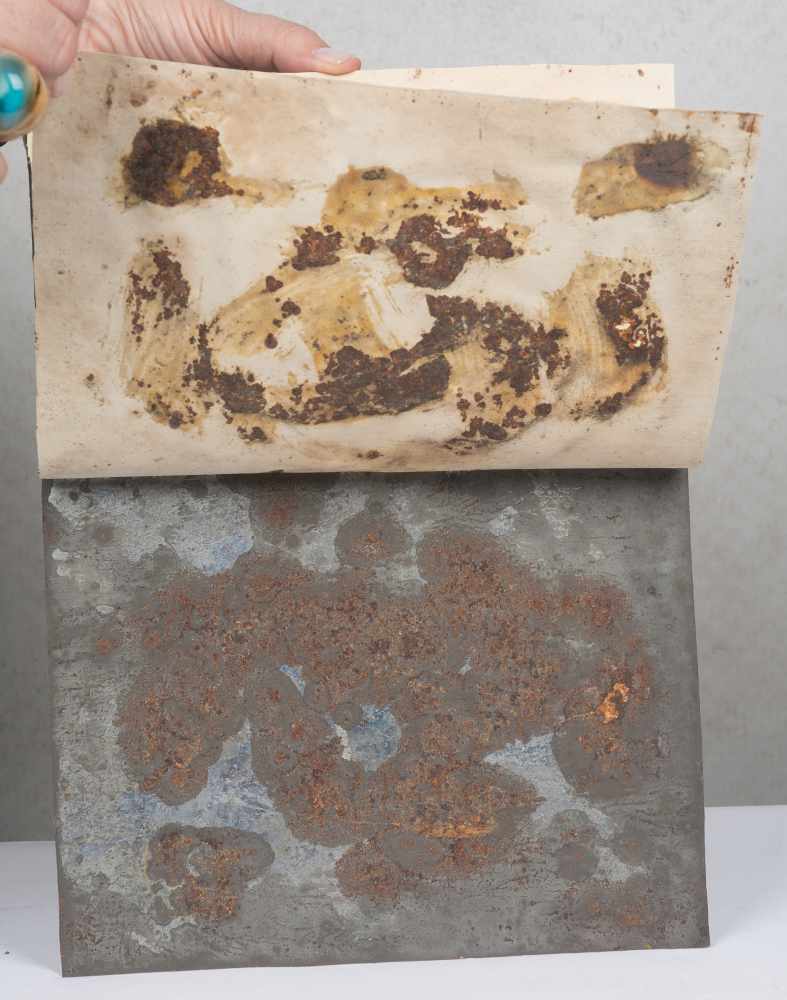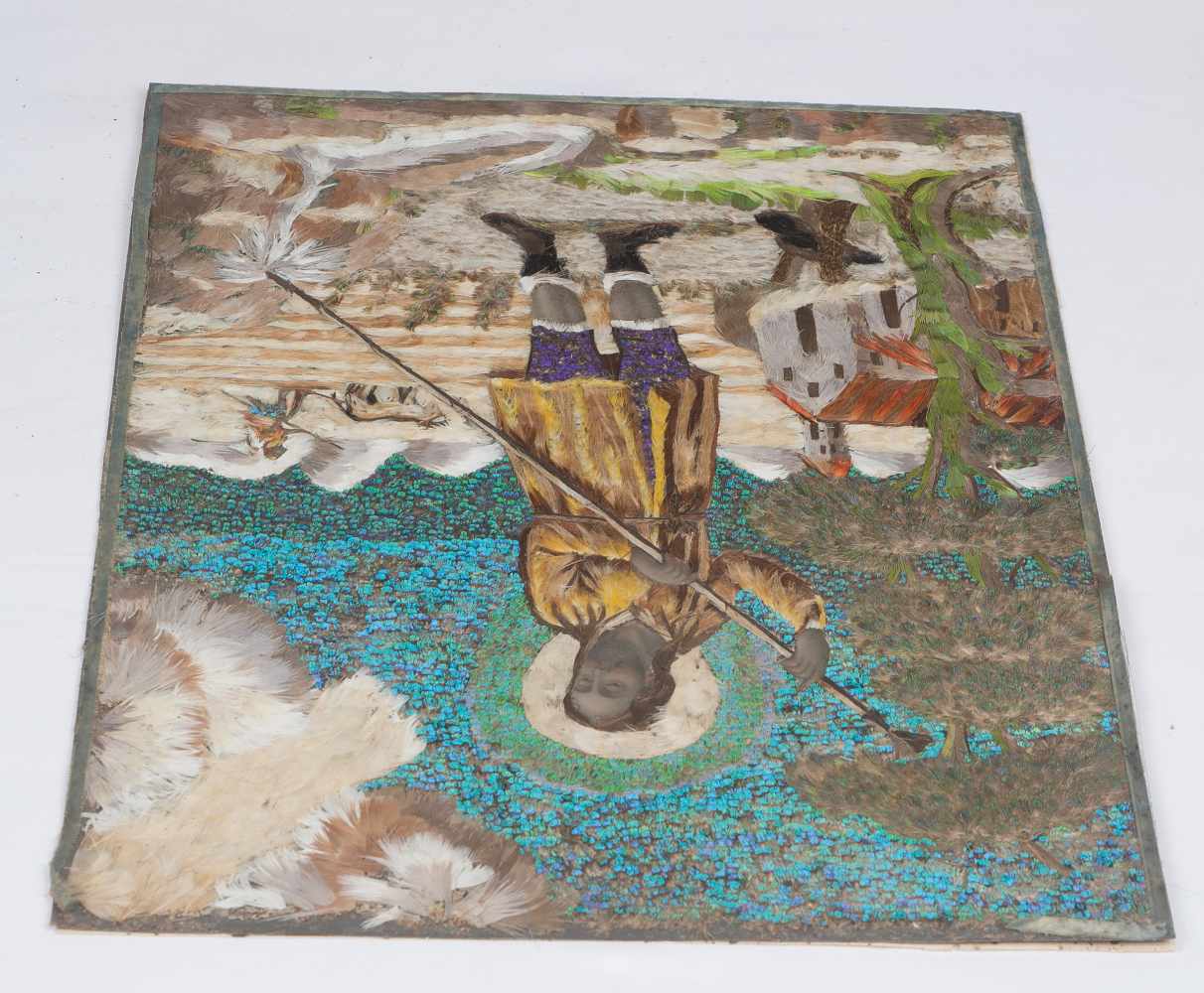2
Featherwork. Mexico. Novohispanic. 18th century."Saint Isidore the Labourer"Featherwork on a metal
"Saint Isidore the Labourer"
Featherwork on a metal plaque, with a multitude of small, richly coloured feathers. The faces and hands are painted in oil. 34 x 24 cm.
The vividness and enormous variety of the colouring of the feathers on this piece are outstanding, giving it an iridescent effect depending on the light.
Its magnificent state of preservation is also outstanding.
When they arrived in Mexico, the Spanish were impressed with the importance the people there gave to the use of feathers. Hernán Cortés, in 1519, sent feathered fans, helmets and shields to Spain.
In 1524 he sent a present of a work of art made using featherwork to King Charles V, and later, in 1527, Cortés sent 38 featherwork pieces to Asia.
Evangelisation changed the subject matter of the art, and the “amantecas” (artists who worked with feathers) began to use this stunning technique to create religious images, many of which were sent to Europe and Asia.
Various examples were sent to different popes in Rome, who in turn gave them as presents to the nobility. This is the reason why some of these featherwork pieces can be found in important European museums.
One of the oldest pieces of featherwork art with a Christian theme is the “Mass of Saint Gregory,” made in 1539 as a gift for Pope Paul II, and which is kept in the Musée des Jacobins de Auch, in France.
Another important piece, made by Juan Correa in the 19th century, “Saint Luke painting the Virgin”, can be found in the Musée de l’Homme in Paris.
Furthermore, a few other examples have been preserved, the most noteworthy of which include those at the Archbishopric of Puebla, the Franz Mayer Museum, the Museo de América in Madrid, the Tepozotian Museum, the Kunsthistorisches Museum in Vienna, and the Museo Nacional de Colombia in Bogota.
The Museo de América in Madrid has thirteen examples of this marvellous featherwork art in its collections. To highlight the symbology and what they represented, there is no better guide than to quote what is said in the technical records of some of these pieces, in which they state:
“Feathers in the pre-hispanic world were directly linked to sacred symbology and with the prestige of those who were permitted to wear them. Quetzalcoatl, the great god who civilised the nahuatl culture, was the mythical master of the amantecas, the artists who congregated especially in the Amantla area of Mexico-Tenochtitlan and who worked with a wide variety of precious feathers. The understanding that the feather was an element of strong symbolic and religious content encouraged the Spanish missionaries to incorporate the expert amantecas within the convent schools, where, alongside the tlacuilos (painters) they learned to interpret European visual representations, and make subtle vestments for the priests of the new religion, and embellish many liturgical and devotional objects with the inclusion of the feather. They began production of small pictures which used Christian narratives as their subject matter, which they learnt about from the friars through the paintings and prints that they selected as models.” (file:///C:/Users/usuario/Downloads/ficha.pdf)
Reference bibliography: Alessandra Russo, Gerhard Wolf and Diana Fane, "Images Take Flight. Feather Art in Mexico and Europe. 1400 - 1700". Hirmer, Munich, 2015.
"Saint Isidore the Labourer"
Featherwork on a metal plaque, with a multitude of small, richly coloured feathers. The faces and hands are painted in oil. 34 x 24 cm.
The vividness and enormous variety of the colouring of the feathers on this piece are outstanding, giving it an iridescent effect depending on the light.
Its magnificent state of preservation is also outstanding.
When they arrived in Mexico, the Spanish were impressed with the importance the people there gave to the use of feathers. Hernán Cortés, in 1519, sent feathered fans, helmets and shields to Spain.
In 1524 he sent a present of a work of art made using featherwork to King Charles V, and later, in 1527, Cortés sent 38 featherwork pieces to Asia.
Evangelisation changed the subject matter of the art, and the “amantecas” (artists who worked with feathers) began to use this stunning technique to create religious images, many of which were sent to Europe and Asia.
Various examples were sent to different popes in Rome, who in turn gave them as presents to the nobility. This is the reason why some of these featherwork pieces can be found in important European museums.
One of the oldest pieces of featherwork art with a Christian theme is the “Mass of Saint Gregory,” made in 1539 as a gift for Pope Paul II, and which is kept in the Musée des Jacobins de Auch, in France.
Another important piece, made by Juan Correa in the 19th century, “Saint Luke painting the Virgin”, can be found in the Musée de l’Homme in Paris.
Furthermore, a few other examples have been preserved, the most noteworthy of which include those at the Archbishopric of Puebla, the Franz Mayer Museum, the Museo de América in Madrid, the Tepozotian Museum, the Kunsthistorisches Museum in Vienna, and the Museo Nacional de Colombia in Bogota.
The Museo de América in Madrid has thirteen examples of this marvellous featherwork art in its collections. To highlight the symbology and what they represented, there is no better guide than to quote what is said in the technical records of some of these pieces, in which they state:
“Feathers in the pre-hispanic world were directly linked to sacred symbology and with the prestige of those who were permitted to wear them. Quetzalcoatl, the great god who civilised the nahuatl culture, was the mythical master of the amantecas, the artists who congregated especially in the Amantla area of Mexico-Tenochtitlan and who worked with a wide variety of precious feathers. The understanding that the feather was an element of strong symbolic and religious content encouraged the Spanish missionaries to incorporate the expert amantecas within the convent schools, where, alongside the tlacuilos (painters) they learned to interpret European visual representations, and make subtle vestments for the priests of the new religion, and embellish many liturgical and devotional objects with the inclusion of the feather. They began production of small pictures which used Christian narratives as their subject matter, which they learnt about from the friars through the paintings and prints that they selected as models.” (file:///C:/Users/usuario/Downloads/ficha.pdf)
Reference bibliography: Alessandra Russo, Gerhard Wolf and Diana Fane, "Images Take Flight. Feather Art in Mexico and Europe. 1400 - 1700". Hirmer, Munich, 2015.
Medieval and Colonial ItemsNetsukes
Sale Date(s)
Venue Address
General delivery information available from the auctioneer
The purchase price includes the delivery of the lots in the venue of the auction. Transporting to other destinations is at the own risk of the client. The customer must contact "LST", to give the corresponding instructions for such transporting. "LST" is not responsible for the packaging or any accident incurred during transportation.
Important Information
Nothing important.
Terms & Conditions
Jorda Alfa SL NIF B-63858187 hereinafter "LST", is aimed at brokering, by deposit, exhibition and auction of antiques, paintings, furniture, jewelry, collectibles or any other similar nature that are entrusted to "LST".
CONDITIONS OF THE AUCTION:
I. REGISTRATION. To bid in the room customers must register at the beginning, filling out a form and picking a number that will identify them during the auction. Customers may be required to register in bank references or other guarantee system and if they do not prove the solvency "LST" will not accept bids and award the auction.
II. WRITTEN BIDS. "LST" will accept written bids, which will be formalized in the form provided by the room until the day before the auction. In such auctions, the room will bid in name of the client until the maximum stated in the offer and always at the lowest possible price. If there are two or more bids for the same amount, the one placed first will have the priority. Written bids received in advance, will have priority on the day of the auction.
III. TELEPHONE BIDS. "LST" will allow telephone bids, if interested people contact "LST" days before the auction providing personal data, ID card and the phone number which will be used by the staff of "LST" to call at the time of the auction. The buyer, within all the legal rights is making an offer for the asking price, when applies for telephone bid. "LST" will not take responsibility for any technical defects beyond its control, which may prevent to contact successfully the bidder during the auction.
IV. AUCTIONEER. The auction will be conducted by an auctioneer, director of the auction will be judge and arbitrator of it with full authority in its development, will award the lots to the highest bidder and is able to settle any controversy concerning lots sale, reject bids, divide lots or group them and remover objects from the room. Will be able to, if it is deemed suitable, not accept bids on the auction. His decision will be unappealable.
V. SALE OF LOTS. The lots are awarded to the highest bidder. Once the auctioneer blows the hammer, the buyer becomes responsible of the lot purchased, exempting "LST" of liability to for any damage and / or accidents that may occur. No refunds of lots.
VI. STARTING PRICE. The amount shown in the catalog as the starting price for each lot will be, as a rule, the minimum selling price, except for exceptional cases where a reservation may be agreed upon with the seller or it set discretionary by the room.
VII. SCALE OF BIDS. The bids are set according to the following scale:
From 50.-€ to 200.-€…………………………………………..at 10.-€
From 200.-€ to 500.-€…………………………………… …20 in 20.-€
From 500.-€ to 1.000.-€………………………………..…..….50 in 50.-€
From 1.000.-€ to 2.000.-€………………………………..…100 in 100.-€
From 2.000.-€ to 5.000.-€……………………………….….250 in 250.-€
From 5.000.-€ to 10.000.-€…………………………………500 in 500.-€
From 10.000.-€ to 20.000.-€……………………………1.000 in 1.000.-€
From 20.000.-€ to 50.000.-€……………………………2.500 in 2.500.-€
From 50.000.-€ to 100.000.-€…………………………..5.000 in 5.000.-€
From 100.000.-€ to 100.000.-€………………………10.000 in 10.000.-€
From 200.000.-€ to 200.000.-€………………………25.000 in 25.000.-€
From 500.000.-€ to 500.000.-€………………………50.000 in 50.000.-€
VIII. RIGHT OF ADMISION. "LST" reserves the right to admission to the auction room and to reject, at its judgment, any purchase order, from clients whose solvency is not duly proved as well as not to sale auctions.
IX. SALE PRICES. The successful bidder of one or more lots must pay "LST" the final sale price achieves at auction, plus the 20 % plus 21% VAT on the commission, at total 24,20 % on Hammer Price.
X. CATALOG DATA. The catalog data are obtainer in order to careful research and advice, however, any responsibility is afforded about its accuracy. The lots will be auctioned in the state in which they are, not accepting any claims in restorations, breakage, damage, imperfections ands, even description or numbering mistakes in the catalog, in case of it, being the burden of the buyers to make sure before the auction that the description matches with their personal opinion about respective lot. The exhibition of the lots is intended to allow a perfect review and study of them.
XI. PAYMENT AND REMOVAL OF LOTS. Payment and removal of the lots will be held no later than five days following the auction. After this period expire without having the buyer removed the lot or lots purchases, it will accrue an expense of custody of 6 euros per day on each lot.
15 days after the auction without having the buyer paid and removes the sold lots, "LST" will inform the seller and there will begin judicial proceeding in order to obtain payment. The delay in payment by the purchaser of his/her sold lots will carry an interest increase at a rate of 1,5% per month.
XII. DELIVERY OF LOTS. The purchase price includes the delivery of the lots in the venue of the auction. Transporting to other destinations is at the own risk of the client. The customer must contact "LST", to give the corresponding instructions for such transporting. "LST" is not responsible for the packaging or any accident incurred during transportation.
XIII. RIGHT OF FIRT REFUSAL AND REPURCHASE. "LST" in order to article 22 of "Ley 9/1993 del Patrimoni Cultural Català" (DOGC. 1897 October 11, 1993) and article 38 of "Ley 16/1985 de 25 Junio del Patrimonio Histórico Español" (BOE. 155 June 29, 1985), will notify in advance to the corresponding Autonomous Community, and to the Ministry of Culture, the content of their catalogs. Concerning the lots subject to the legislation referred to in the preceding paragraph, the Civil Service may exercise the rights of first refusal and repurchase according to the law. "LST" will watch over the protection of Artistic, Historical and Bibliographical Heritage of Spain.
XIV. VALUE ADDED TAX (I.V.A). This tax will be accrued on commissions of "LST" for buyers, using the rates prevailing on the date of the auction.
XV. DATA PROTECTION. In order to the "Ley 15/1999 de 13 de Diciembre, de Protección de Datos de Carácter Personal", the client authorize "LST", the inclusión of their data in a customer file, and for the promotion by "LST" of the objects at all times the rights of access, rectification or deletion of personal data by sending the appropriate request to the following address: LA SUITE SUBASTAS, C/ Conde Salvatierra, 8, 08006. Barcelona .
XVI. EXPRESS LEGAL JURISDICTION. These Conditions are governed by and interpreted in accordance with the rules of Spanish law. The mere act of participating in the auction as seller, buyer or bidder, implies acceptance of these Terms and Conditions.
Sales operations are understood to be held at the registered office of "LST", C/ Conde de Salvatierra, 8, 08006. Any dispute shall be taken to the competent courts of Barcelona, expressly waiving any other jurisdiction, in accordance with Article 55 of the "Ley de Enjuiciamiento Civil".















